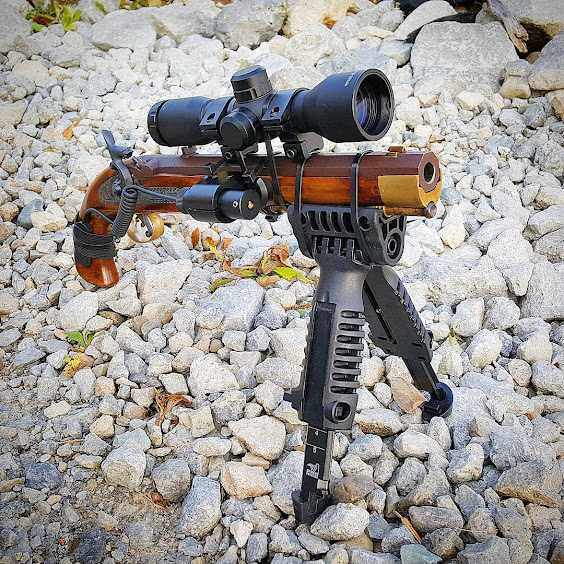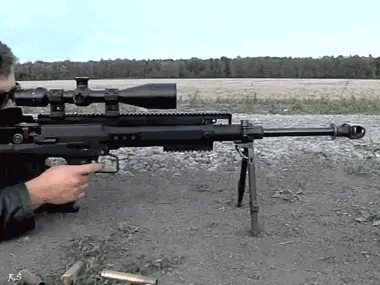
Red dots: a simple term that invokes hundreds of different optics. Some of these optics don’t even have red dots but are still considered red dot scopes.
Odd, I know, but welcome to the wonderful and weird world of red dot scopes. The AR-15 and the red dot scope is a perfect pair that’s been around since the inception of the red dot.
Today, we are going to explore and review red dots for your AR-15 at every budget, talk specs, pros, and cons, as well as give you the power to choose the perfect red dot for you.
When you finish this article, you’ll be well prepared to purchase a red dot for your AR-15.
The 8 Best Red Dot of 2019: Outdoor Empire Reviews
Here is a list of the top AR Red Dots of 2019:
- Best Budget Red Dot: Vortex Optics Crossfire
- Best Under 100 Bucks: TRS 25
- Best Under 200 Bucks: SIG Romeo 5
- Best for the Money #1: Trijicon MRO
- Best for the Money #2: Holosun HS510C
- The Best Overall #1: Aimpoint Comp M4
- The Best Overall #2: Eotech EXPS3
- The Best Overall #3: Trijicon RMR Type 2
1. Best Budget Red Dot For AR-15: Vortex Optics Crossfire
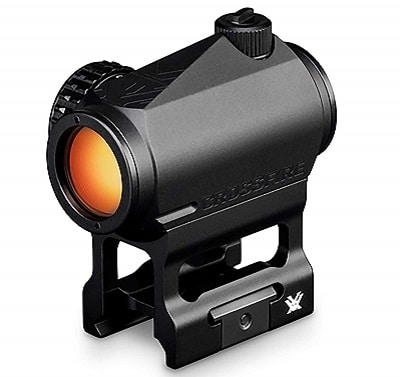
Vortex Optics is well known for their series of affordable but high-quality red dot optics. Their brand has grown quickly in a short period of time, and they are serious contenders in the optics world.
The Crossfire provides excellent value and is a great budget-ready red dot for any AR-15.
The Crossfire comes with two different mounts, further adding to its value. These optics allow for a low mount or a low mount with a one-third co-witness. This allows you to use your iron sights through the optic in case the optic fails.
The provided reticle is a crisp 2-MOA dot that is easy to see and can be adjusted to 11 different intensity levels.
The Crossfire has a fully-multi coated lens that increases light transmission and provides an excellent and clear picture. The Crossfire is simple but reliable and built to be shock-, water-, and fog-proof.
Features and Specs
- Aluminum body for excellent durability
- 2.5 inches long, weighs 5.2 ounces
- 12-hour auto-shutoff, just in case
Pros
- Comes ready to shoot out of the box
- Co-witnesses with AR-height sights
- Battery seems to last forever
Cons
- Small objective lens will turn some off
The Vortex Crossfire is the optic for those who want an out-of-the-box option that’s ready to hit the ground running. There is no need to buy a battery or mount: just open it, install it and start shooting.
2. Best Under 100 Bucks: TRS 25
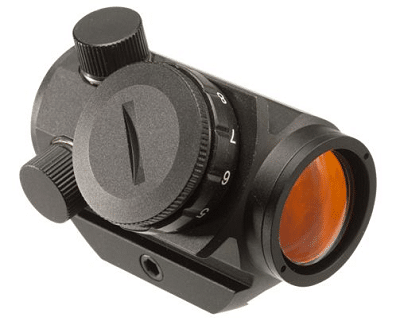
The TRS 25 is one of the few red dot scopes that cost under a hundred bucks and are actually worth owning.
The TRS 25 is made by a company called Bushnell, which is known for its quality, low-price optics. The TRS 25 is a compact red dot optic that is designed with rifles and shotguns in mind.
It is compatible with a variety of risers that allow it to co-witness with standard-height AR-15 sights. The TRS 25 is easy to use and comes with an integral mount for Picatinny rails. The optic is shockproof and will take a good bit of abuse before it falters.
The optic is even water proof and shockproof. It’s O-ring sealed and nitrogen purged to maintain a high degree of reliability and clarity.
The red dot is a 3-MOA dot, making it perfect for a rifle, and this allows you to easily see your target but still have a reticle that’s big enough to see with ease and speed.
Features and Specs
- 3-MOA reticle
- 11 brightness settings
- 2.4 inches long and weighs 3.7 ounce
Pros
- Affordable, but high quality
- Great variety of brightness settings
- 100%shock-, water-, and Fog-proof.
Cons
- Needs risers to co-witness
he TRS 25 is a small, lightweight optic that is designed to be functional and useful. It’s not a duty-grade optic, but for plinking, competition, and even home defense, it’s a reliable choice.
3. Best Under 200 Bucks: SIG Romeo 5
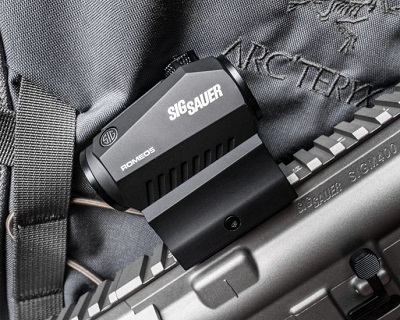
The SIG line of optics has gotten a ton of praise in a short period of time. The Romeo 5 and Romeo 5XDR are both solid optics that come in at under 200 dollars.
The standard Romeo 5 is the most affordable, but the 5XDR offers two reticle options.
The Romeo 5 is a compact red dot with a 20 mm objective lens and is powered by a single battery that lasts 40,000 hours.
The optic has 10 brightness settings, with two of the settings being night-vision compatible. The Romeo 5 can become quite bright, and it’s perfect for the sunniest of days.
The SIG MOTAC technology means you can have an instant optic without having to leave the optic powered up. When it senses motion, it turns itself on. When it sits still, it shuts off. It’s a reliable system that doesn’t fail.
Features and Specs
- 10 brightness settings
- lPX7 rating for complete water immersion
- Comes with standard-and low-rise mounts
Pros
- Extremely long battery life
- MOTAC system is incredible
- Very clear optics for an excellent sight picture
Cons
- XDR model is only a penny under 200 bucks
The SIG Romeo 5 is about the best you are going to get from an optic under 200 bucks. It’s an affordable and reliable design that incorporate a variety of modern technologies. The Romeo 5 is an awesome optic at a great price.
4. Best Red Dot Sight For The Money #1: Trijicon MRO
![]()
The Trijicon MRO is a slightly pricier optic, but when it comes to bombproof optics, Trijicon is a major name in the game. The Trijicon MRO is a circular optic on a compact frame. This optic sports a 25 mm objective lenses with a 2-MOA red dot.
The MRO was built for the AR-15, and it shows. The optic has a variety of mounts available that allow different levels of co-witness es with AR-height sights.
It’s made from strong and dependable 7075 aircraft-grade aluminum, and the glass is fully multi coated and extremely clear.
I mentioned bombproof above and meant it. The MRO is incredibly durable and can even be submerged in water up to 100 feet and still work. The optic also offers eight brightness settings, two of which are night-vision compatible.
Features and Specs
- 25 mm objective lens, 2.6 inches long, and 4.1 ounces
- 5 daylight settings, 1 ultra-bright setting, 2 night-vision settings
- 2-MOA reticle
Pros
- 5-year battery life
- Crisp and clear red dot
- Easy to co-witness with
Cons
- Slight blue around the edges
The MRO is a pro-grade optic at a mid-tier price. Like everything Trijicon makes, this optic is designed to be beaten up, tossed around, and used like hell. It will just keep working.
The MRO is perfect for duty use as well as home defense, hunting, and competition.
Trijicon MRO is also available at:
5. Best For The Money #2: Holosun HS510C
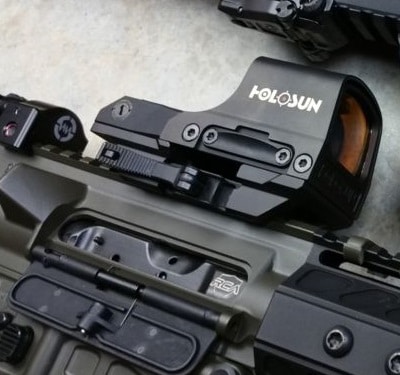
Holosun gets a little shade thrown their way for being imported optics, but the community is starting to embrace them because they work and come at an amazing price.
The HS510C uses a nontraditional rectangular window design that allows for a more natural two-eyes-open shooting style.
The reticle is a 65-MOA ring with a 2-MOA dot placed in the center. This is a versatile reticle that allows for both quick and decisive short-range shooting and slow, more precise moderate-range shooting.
The HS510C has a solar panel to gather light as the main power source but includes a CR2032 battery as a backup. On its own, the battery can last up to 50,000 hours on a medium setting.
The HS510C is built to last and makes use of aircraft grade aluminum, as well as titanium alloy to provide a strong and durable design.
Features and Specs
- Included QD mount
- Shake Awake motion sensing tech to power on the unit
- Reticle can be converted to dot or 65-MOA ring only
Pros
- Solar panel makes the battery almost unnecessary
- Quick and easy to use when shooting
- Unbelievably strong for such an affordable price
Cons
- A hefty 9.3 ounces
The HS510C is the perfect optic if you need a duty optic on a budget. The HS510C is a potent sight at a great price and can easily keep up with the big boys.
Holosun HS510C is also available at:
6. The Best Overall Red Dot Sight #1: Aimpoint Comp M4
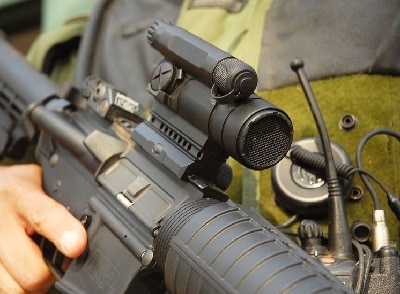
The Aimpoint Comp M4 is easily one of the best overall red dots of all time. Aimpoint invented the red dot scope and have improved on it over and over.
The Comp M4 is the optic of choice for the United States Army, and it’s served in the Global War on Terror extensively.
The CompM4 is a great red dot optic that will last 80,000 hours on a single battery. The Aimpoint has seven night-vision settings and nine daylight settings,with one extra-bright setting. This professional-grade optic produces one of the crispest red dots out there.
The glass is incredibly clear, and the multi-coated lenses offer amazing light transmission for a clear picture. The sight is also built extremely well, and it can be submerged 150 feet underwater and still work.
Features and Specs
- 6 different brightness settings for 24-hour performance
- Can be used with a multitude of mounting solutions
- Uses a standard AA battery
Pros
- One of the toughest optics ever
- Extremely long battery life
- Compatible with magnifiers and night vision
Cons
- Expensive
The Aimpoint Comp M4 is the optic for those looking for a simple, rock-solid design that they can depend on no matter what. The Comp M4 is a duty-grade optic designed for tactical use, but it’s capable of fulfilling any role you toss at it.
7. The Best Overall #2: Eotech EXPS3
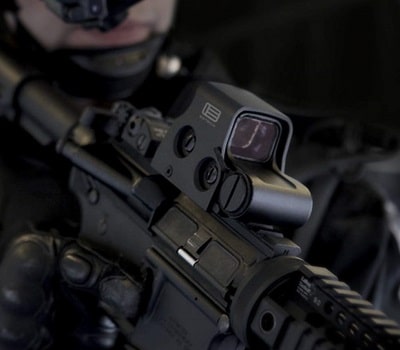
The Eotech brand is probably second only to Aimpoint in terms of popularity and use. Eotech optics are designed to be a bit more versatile than Aimpoint optics at the cost of battery power. The EXPS3 is compact, having a reduced size everywhere but the viewing window.
Eotech products are well known for being in use with the shooters in Marine Special Operations Command, as well as SEAL Team 6.
These optics are favored for their durability, their versatility, and their compact size. The EXPS3 offers a holographic reticle that works more intuitively with magnifiers.
The famed Eotech reticle with its 68-MOA ring and 1-Moa dot makes for quick and easy sight use for both short-and moderate-range engagements. The EXPS3 offers 20 daylight settings and 10 night-vision settings.
Features and Specs
- 30 different settings
- Holographic reticle
- Auto-shutdown and low battery warning
Pros
- Versatile for moderate and close range shooting
- Night-vision compatible
- The small size means easy magnifier mounting
Cons
- Low battery life
The EXPS3 is an excellent optic for duty rifles as well as home defense setups. The optic functions brilliantly with a magnifier to provide a true close-, moderate-, and extended-range optic, and this versatility makes the EXPS3 the best version of Eotech’s optics.
Eotech EXPS3 is also available at:
8. The Best Overall #3: Trijicon RMR Type 2
![]()
The Trijicon RMR is the smallest optic on this list and is a miniature red dot sight. These mini red dot sights can be used on nearly any gun on the market, from ARs to handguns.
On an AR, it’s best used for those dedicated to close range use, such as short-barreled AR pistols or SBRs.
The Trijicon RMR is the lightest optic out there built to a duty-grade standard. This miniature red dot sight enables two-eyes-open shooting, allowing fora wide field of view and a crisp red dot.This optic is also water-, shock-, and fog-proof.
The RMR can be utilized as a main optic or as a backup to a gun that is wearing a magnified optic. Either way, the RMR is the best duty-grade miniature red dot on the market, and if you want to go light and small, the RMR is the way to go.
Features and Specs
- 4-year battery life
- Top loading battery design
- Weighs 1.17 ounces and is only 1.8 inches long
Pros
- Super-light and small
- Tons of mounting options available
- Comes with an automatic and manual brightness settings
Cons
- Expensive for such a small optic
The Trijicon RMR is the optic for those pursuing a lightweight optic designed for a small and light weight rifle. The Trijicon RMR is a miniature red dot that excels for close-quarters use. It’s not the end all be all optic, but for lightweight guns, it’s hard to beat.
What Exactly is a Red Dot Sight?
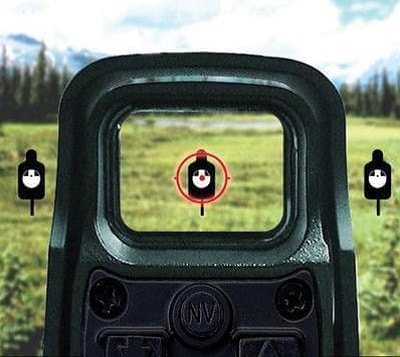
A red dot sight is an optic that is designed to be simple, precise, and effective at close to moderate ranges and are named so for their traditional red reticle.
However, as time passed some of these optics now come with green reticles, but the term red dot still includes these optics.
Red dot sights are 1x, meaning they do not utilize internal magnification.Therefore, red dots are designed generally for engagements out to 300 yards involving man-sized targets.
Red dot sights are incredibly popular on AR-15s. They take a standard infantry rifle and simplify aiming and shooting one accurately.
Why Should You Get a Red Dot Sight?
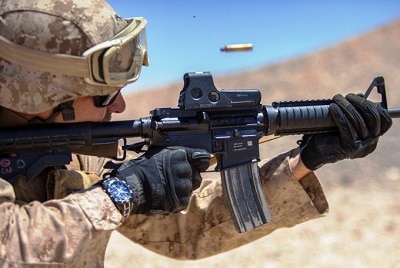
Red dot sights were a major step forward in practical and tactical shooting. These dots are designed to get you on target as quickly as possible and allow you to be precise, making the mare superior to iron sights in many ways.
Red dot sights are designed to simplify the shooting process.While iron sights require you to precisely align the front and rear sight and then aim the front sight on the target, a red dot just involves putting the dot on the target and pulling the trigger.
Red dot sights are simpler overall and are superior in every way when doing rapid shooting.They allow you to track moving targets with ease, you can transition between multiple targets very quickly, and they allow you to precisely place your shots in a combat environment.
Red dot sights also offer you superior low-light performance. A glowing dot is much easier to see than a black iron sight. Some red dot sights are also compatible with night-vision devices, which increases their versatility tenfold.
How to Choose Your Red Dot?
With so many different red dots on the market, it can be hard to pick which is best for you. The market is so large that you have options at nearly any budget point.
Red dot optics are designed for close to moderate ranges, but there are tons of other factors to consider prior to making a purchase.
Let’s cover the most important considerations here so you can walk away ready to make an informed purchase.
Size of the Red Dot Body
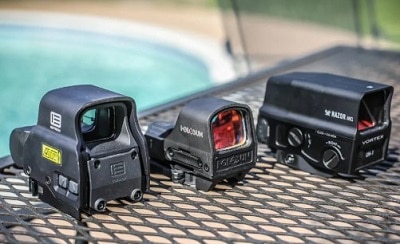
Red dots come in a variety sizes, and the red dot market has never really decided on a measurement standard. However, most of the market defines red dots as being in three different size categories: miniature, compact, and full size.
Mini red dots
Miniature red dots are small enough to go on a pistol and are often the go-to choice for ultra-small guns, including handguns. Miniature red dots are not the most common optic to find on ARs, but it’s not unheard of either.
These red dots are ultra-lightweight and provide a great option for close-quarters use, but they are typically tougher to use at moderate ranges.
Please see our article on best red dot sights for pistol for more in-depth information on mini red dots.
Compact
Compact red dots are typically red dots with an objective lens between 20 and 25 mm. These compact optics are light and small but offer a true red dot optics experience.
These compact red dots are typically a good compromise between small size and full power. They are easy to us eat most ranges but suffer from small battery and intensity problems.
Full-sized
Full-sized red dots are typically 26 mm and above. These red dots are designed for duty use and often pack a full-sized battery for extended run times.
These optics are also more compatible with a wider variety of mounts and accessories. They are also larger and heavier.
Reticle Size
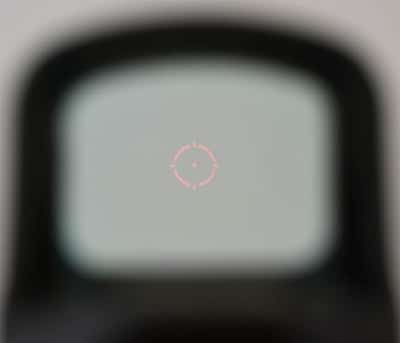
While the reticle for a red dot is a simple dot, they do vary in size. Reticle size is measured in MOA, or minutes of angle, which is a term you’ll see a lot when it comes to rifles.
1-MOA is equal to 1.047 inches at one hundred yards. We round that 1.047 inches down to 1 inch for simplicity.
A 1-MOA dot will appear to cover one inch of the target at 100 yards. Red dot reticles generally range from 1-MOA to 9-MOA.
The smaller the reticle, the easier it is to place precise shots at longer ranges. You’ll be able to see more of the target with a smaller dot.
Bigger dots make it harder to see targets at longer ranges but are faster to find and quicker to get on target. These dots cover more of the target, so they can be more challenging to see the actual targets at longer ranges.
Reticle Design and Color

Most red dot reticles are just red dot reticles—that’s it. That’s where the name comes from. A simple red dot helps immensely with aiming. Put the red dot on the target, pull the trigger, hit the target. It’s pretty flippin’ simple, but people like to make things a little more complicated.
Companies like Eotech, SIG, Holosun,and more have added additional dots, larger rings, cross hairs,and more. When purchasing a red dot optic, you may want to check out the provided reticle.
I know when you call something a red dot it should be self-explanatory, but that’s just not how it goes.
Color is another concern. While they are called red dots, they come in different colors. The two common colors you’ll see being used as reticles are green and amber.
Some people see these colors easier, and green light supposedly uses less battery power.
Magnifier Compatibility
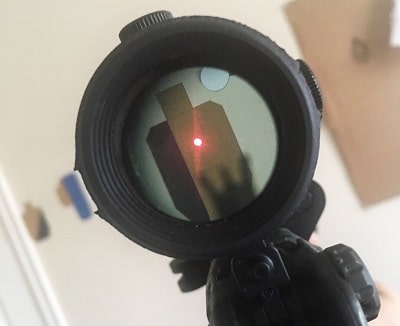
Full-size and compact red dots are often compatible with magnifiers. These magnifiers typically run between three to six power and allow you to see further with more precision than a standard red dot optic.
Magnifiers can make it so red dots can be used at extended ranges with ease.
If you want to extend beyond typical red dot ranges,you should consider a red dot’s ability to utilize a magnifier.
Check out the best red dot magnifiers on the market!
Durability
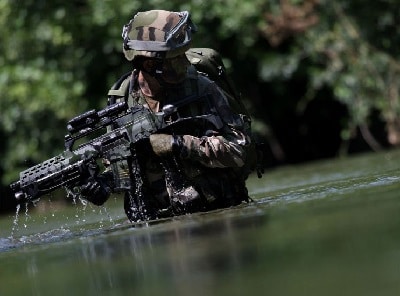
When researching red dots,you should look for terms like shockproof, waterproof, nitrogen purged, and submersible. Cheap, junky Chinese red dot optics will not stand up to bumps, bruises, a little water, or heavy recoil.
If you are looking for an optic that can be used for duty, you need to research if the optic is proofed.
The stronger the optic,the higher the cost will be, but the last thing you want your optic to do is crap out in a pinch.
Battery Life
What’s Your Need?

How are you planning to use your optic? That is going to be the biggest consideration, next to your budget. If you are a cop looking to outfit your AR as a patrol rifle, you are going to have to spend a bit more money than a hobbyist looking to punch paper.
Self-defense and duty use will require a strong and durable optic with excellent battery life. They may even need night-vision compatibility, and they will certainly need a variety of different dot intensity levels. You’ll also want compatibility with a magnifier.
Competition shooters will need an optic that works and is durable. They will not likely need an optic with night-vision compatibility but will likely want a magnifier. Hunters are in the same boat as comp shooters.
Hobbyists can do whatever they want since their task is just hit the target.
Examine your chosen task and the conditions in which you are going to be using your AR-15 and optic. Be honest, have realistic expectations, and set a reasonable budget.
Top Red Dot Brands
Aimpoint

Aimpoint is known for designing the first red dot scope ever. They produced the first model in the 1970s and have continued to push the concept further.
Aimpoint optics are designed for serious use and serve with the United States Army and Airforce, proving that they produce top-tier red dot scopes.
Aimpoint Optics are designed to last for a very long time. These optics are rock solid and well made—they have to be since they produce optics for the tactical industry, including the United States military and police forces worldwide.
Aimpoint makes optics of varying sizes, including full-size, compact, and miniature models. Aimpoint also designs optics at a variety of budget levels.
Some cost as much as 800 bucks,and others can be had for 400 bucks. They are never considered cheap, but their quality is second to none.
They produce mostly tactical optics but have expanded into the hunting realm with the H-1 optic. The H-1 is used for shotguns, bows, etc.
Aimpoint also produces magnifiers and mounts for their optics, delivering a full optics experience. It’s hard to beat Aimpoint.
Eotech

Eotech started their company by doing something different. They used a much more complicated holographic system to provide a more versatile red dot reticle and to open up possibilities for a more complicated red dot system.
The use of a holographic red dot system allows Eotech to design the famed 68-MOA ring and the 1-MO Acircle reticle. This is their most famous red dot system and one that they keep to this day.
In addition to their original reticles, Eotech also designed reticles with two dots to compensate for drop from the 5.56 round. Other reticles include options for machine guns, less lethal launchers, and .308 caliber rifles.
Holographic reticles are also more intuitive to use with a magnifier. The magnifier magnifies the target but not the dot itself. This makes it easier to see your target when utilizing a magnifier.
Eotech is mostly known for the military and law enforcement market, but in recent years they have embraced the civilian market.
Eotech optics are now out there for hunters and competition shooters at lower prices but with equal quality. The difference is typically the presence of night-vision compatibility and size.
Learn more about holographic sights.
SIG

SIG, the famed firearms manufacturer, has dived deep into creating everything from guns to silencers to optics. SIG didn’t just create one red dot and call it a day; they simultaneously released tons of different models.
Their red dots are out there at all sizes and budgets. This includes miniature, compact, and full-sized red dots. Prices vary from a little over $100 to $600 or $700.
They also produce magnifiers, thermal optics, and more. SIG as a company is hard to pin down for what they are known for.
Their more affordable optics are perfect for competition, home defense, and even close-range hunting. However, professionals like the SAS are using the Romeo 4, and the FBI approved the Romeo 4M for their agents.
Without a doubt, SIG is making a big impression and is wanting to conquer both the professional tactical market and the budget red dot market with its wide variety of optics.
SIG is going everywhere,and personally, I love these optics and use several on my own guns.
SIG isn’t changing the technology or making crazy innovations, but they are producing rock-solid optics that work well.
F.A.Q
How do red dot sights work?
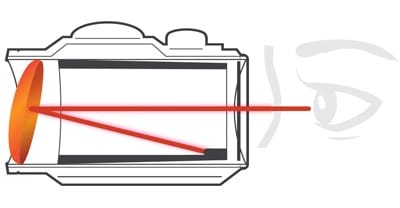
There are a few different types, but we’ll cover how the most common red dot sights work as simply as possible. A red dot sight projects a laser onto a piece of tinted glass. This glass is invisible to the naked eye allows for the reflection of certain colors, one of those colors being red.
When you look through a red dot sight,you are actually seeing the reflection of a red light. This does involve the light being aimed upwards and the glass being slanted and some tricky construction, but that’s the best way to explain it.
Which red dot sight does the military use?
The main red dot sight the military uses is the Aimpoint Comp M4. The Comp M4 is the optic issued to most soldiers in the US Army. However, some special units utilize the Etech EXPS3 series, as well as the Trijicon RMR and the Elcan series in various roles.
Are red dot sights lasers?
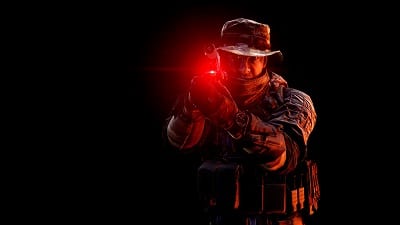
No, this is a common misconception for those new to guns. Laser sights themselves are a red dot you aim with, but red dot sights are a reference to the reticle these optics often use.
How to use a red dot sight?
We have a great article on using, zeroing and mounting a red dot sight.



